
Home |
||
|---|---|---|
Before the exhibitions |
Eight Impressionism exhibitions |
After the exhibitions |
|
||
»6ᵐᵉ Exposition de Peinture«
1881
Sixth exhibition in Paris in 1881
2 April to 1 May 1881
Boulevard des Capucines 35 (rear building)
170 works in the catalogue (6 out of catalogue) - 13 artists
While the fifth exhibition had already led to fierce disputes between the artists, if only over the terms "Impressionist" or "independent" for the title of the event, there was once again much controversy over the participants. Only three of the well-known Impressionist painters who had put their heart and soul into the exhibitions and organised them over the years remained: Berthe Morisot, Camille Pissarro and Gustave Caillebotte.
However, there were also differences of opinion between them when they were planning the sixth exhibition. Caillebotte explained his point of view in a letter to Pissarro. He was very annoyed at the way Degas had included his friends in the exhibitions, who in everyone's opinion were not Impressionists, such as Raffaëlli, Rouart, Tillot, Vidal or Zandomeneghi, among others. He therefore suggested that only those who were genuinely interested in Impressionism should be included in a new exhibition. He presented Pissarro with the following list in a letter dated 24 January 1881: "You (Pissarro), Monet, Renoir, Sisley, Mme Morisot, Mlle Cassatt, Cézanne, Guillaumin; if you wish, Gauguin... and me. That would be all of them, since Degas will refuse such an event." He added: "Degas created dissension among us. It's a pity that he has such an unpleasant character.... If Degas wants to take part, he should come, but without the people who follow him."
Pissarro could not and did not want to upset Degas and wrote back: "He (Degas) is a terrible person, but honest and decent!" Pissarro was indebted to Degas because he had helped him a great deal in difficult financial times.
Even though the conditions were difficult, an exhibition was organised in a backyard house on the Boulevard de Capucines, with the Nadar studio in the front building. Caillebotte had decided not to take part himself after Pissarro's rejection letter. This left only Mary Cassatt, Edgar Degas, Paul Gauguin, Berthe Morisot and Camille Pissarro among the well-known Impressionist painters. With the exception of Pissarro, only those who had always been financially well-off remained.
A total of 13 artists showed their works. However, Degas' contribution, which was the subject of the dispute, was rather meagre, although he had taken on the organisation. Berthe Morisot also contributed only a few pictures. Pissarro showed the most with 28 pictures.
Emile Zola then wrote in a newspaper that the Impressionist group no longer existed.
According to the catalogue, the following artists took part in the exhibition: Mary Cassatt, Edgar Degas, Jean-Louis Forain, Paul Gauguin, Jean Baptiste Guillaumin, Berthe Morisot, Camille Pissarro, Jean-François Raffaëlli, Henri Rouart, Charles Tillot, Eugène Vidal, Victor Vignon, Frederico Zandomeneghi.
Organiser: Edgar Degas
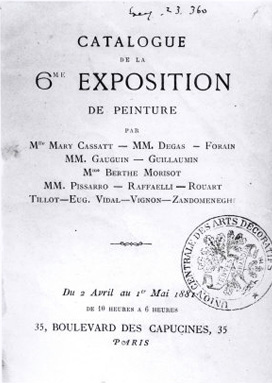
Exhibition catalogue
Examples from the sixth Impressionist exhibition in 1881
The numbers listed in the 1881 catalog are placed before the image title below. The art techniques or descriptions specified in detail in the catalogue are also listed.
The image titles correspond to those in the 1881 catalog. (Today, some titles are different.)
The provenance information lists those research sources
that provide reliable evidence for the respective work in the exhibition.
• = The sources for the 1881 exhibition suggest a possibility or assumption
that the painting may have been shown in the exhibition.
> Moffett = Charles S. Moffett: The New Painting, 1974
Catalogue with details of exhibited works in 1881
> Berson = Ruth Berson: The New Painting, 1996 (Volume 2)
Presentation of documented works exhibited in 1881
> Museum = Information in the museum's collection on the work's exhibition history
> Catalogue Raisonné = Artist's catalogue raisonné with exhibition details
> Newspaper reports 1881 = Ruth Berson: The New Painting, 1996 (Volume 1):
Related reports in (mostly) Parisian newspapers in 1881 on the exhibition
Edgar Degas
The figure of the dancer was Degas' most important artistic contribution to this exhibition. Not as a cast, however, but as a wax model with a tulle skirt and hair bow. What can be admired in some museums today is a bronze cast that was only made after Degas' death.
Firstly, two drawings: As always, Degas had dealt with the subject very carefully. (These preliminary drawings were not shown in the 1881 exhibition, only the figure itself!):
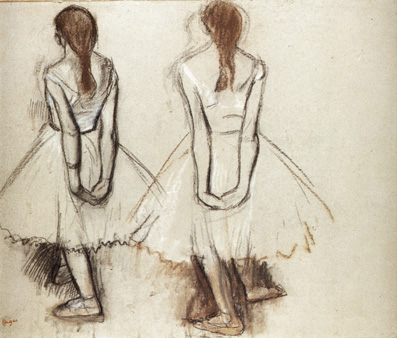
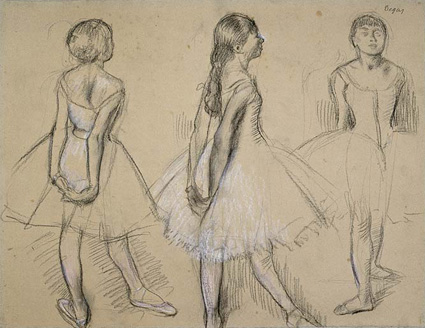
Designs, not in the exhibition
8 Works in the catalogue
The original figure is now kept and displayed in the National Gallery of Art, Washington DC:
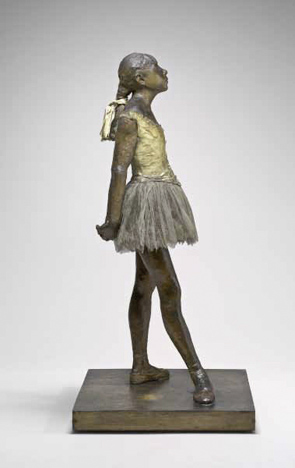
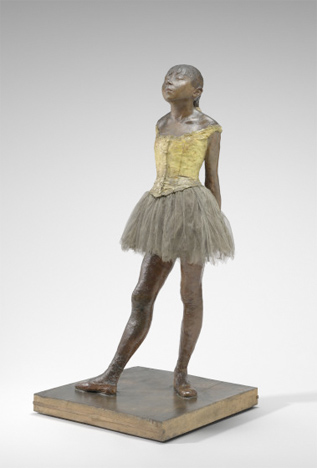
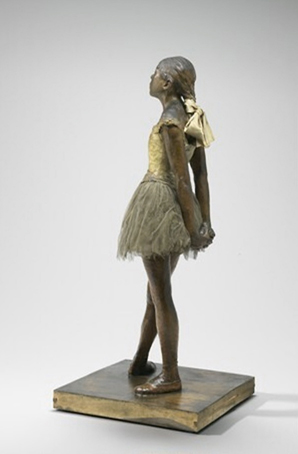
No. 12 - Petite Danseuse de quatorze ans (statuette en cire).
1878/81 - Height 99 cm - pigmented beeswax, clay, metal armature, rope, brush, human hair, silk and linen ribbon, cotton faille bodice, cotton and silk tutu, linen shoes, on wooden base
National Gallery of Art, Washington, USA >
Provenance: Moffett/Berson/Museum/Millard: Catalogue Raisonne Sculptures of Edgar Degas/Newspaper reports from 1881
It was the only sculpture that Degas ever exhibited. The figure was also viewed very critically when it was shown in the exhibition for the first time. The critics protested almost unanimously that it was ugly, but had to recognise the astonishing realism of the work as well as its revolutionary character. The writer Joris-Karl Huysmans had these words for the sculpture: "... all the public's ideas about sculpture, about these cold, lifeless, white apparitions, about these memorable, mould-like works that have been repeated for centuries, are overturned. The fact is that Monsieur Degas overturned the traditions of sculpture...." (J.-R. Huysmans - "L'Exposition des indépendants en 1881" in L'art moderne). In contrast, the critic Paul Mantz asked in the newspaper "le Temps": "...why such a figure, whose forehead and lips have such a malicious expression, is exhibited at all." (Paul Mantz: "Exposition des œvres des artistes indépendants" in "Le Temps" on 23 April 1881)
Otherwise, Degas only contributed a few works because he had learnt of the dispute between Caillebotte and Pissarro and felt he had to hold back.
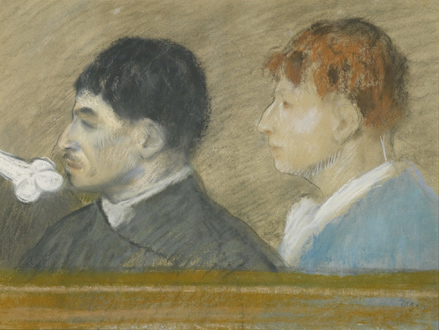
No. 17 - Physionomie de criminel.
1881 - 64 x 76 cm - Pastel on paper
Private collection
Provenance: Moffett/Berson/Sotheby's/Catalogue Raisonné Edgar Degas/Newspaper reports from 1881
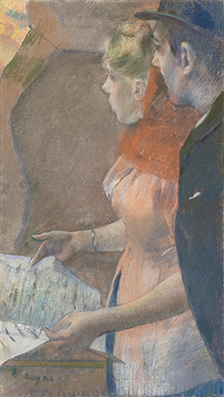
(except catalogue) hc. - Vue de Coulisses
ca. 1881 - 67 x 38 cm - Pastel on linen
Private collection
Provenance: Moffett/Berson/Newspaper reports from 1881
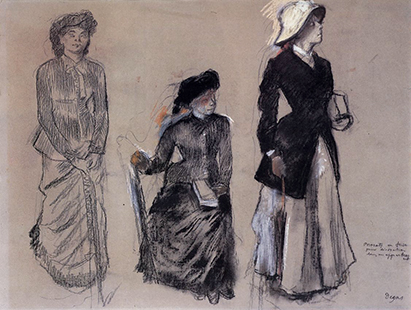
(except catalogue) hc. - Portraits en frise
ca. 1881 - 50 x 65 cm - Black chalk and pastel on linen
Private collection
Provenance: Moffett/Berson/Catalogue Raisonné Edgar Degas/Newspaper reports from 1881
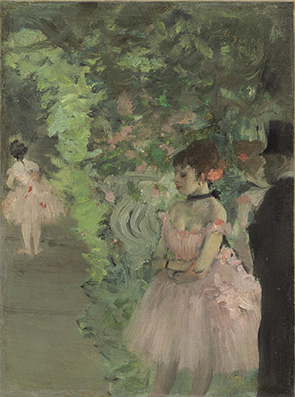
(except catalogue) hc. - Vue de coulisses.
1876/1883 - 24,2 x 18,8 cm - Oil on canvas
National Gallery of Art, Washington, USA >
Provenance: Moffett/Museum/Newspaper reports from 1881
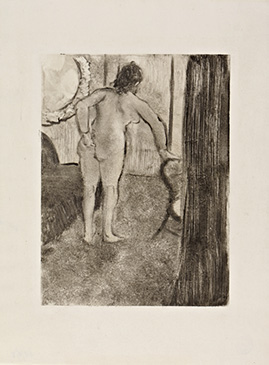
(except catalogue) hc. - Femme nue
ca. 1879 - 31,5 x 23,3 cm - Monotype
Cantor Arts Center, Stanford, USA >
Provenance: Moffett/Newspaper reports from 1881
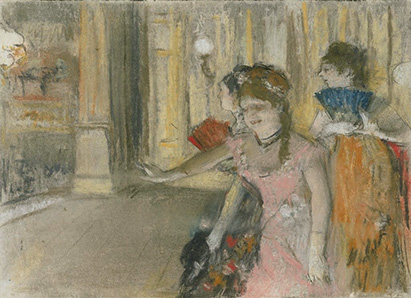
(except catalogue) hc. - Chanteuses en scène.
ca. 1877/79 - 12 x 16,9 cm - Pastel over monotype and graphite
Art Institute Chicago, USA >
Provenance: Moffett/Newspaper reports from 1881
Mary Cassatt
Mary Cassatt had an admiring friendship with Degas, which often broke down due to the nature of the painter. Conversely, Degas also admired the American painter, who was so very much a "lady". He painted her several times, used her as a model for his series of milliners and immortalised her in the beautiful drawings "Mary Cassatt in the Louvre".
She did not count herself among the Impressionists with whom she exhibited. Nevertheless, the influence of Renoir and Degas can certainly be seen in her paintings. She translated the style of both painters into a feminine one. Since she followed Manet, Renoir and Degas, she concentrated almost exclusively on portraits. However, she kept away from the artistic hustle and bustle of her Impressionist colleagues. In her flat, she was a confident hostess for statesmen, poets and famous artists.
11 Works in the catalogue
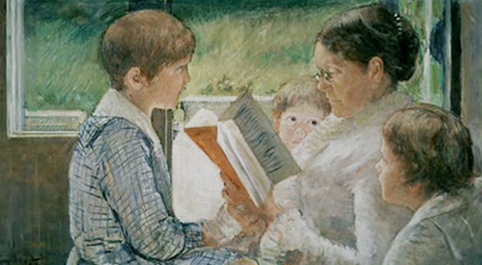
No. 1 - La Lecture. Peinture.
1880 - 58 x 100 cm - Oil on canvas
Private collection
Provenance: Moffett/Berson/Newspaper reports from 1881
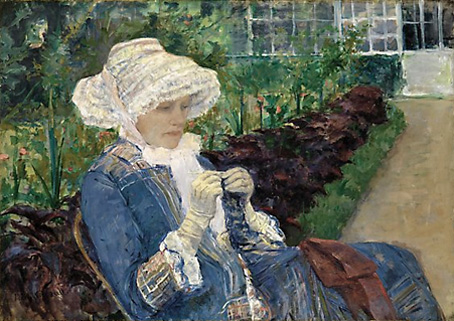
No. 2 - Le Jardin. Peinture.
1880 - 66 x 92 cm - Oil on canvas
Metropolitan Museum of Art, New York, USA >
Provenance: Moffett/Berson/Newspaper reports from 1881
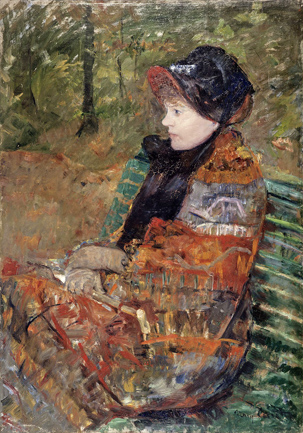
No. 3 - L'Automne. Peinture.
1880 - 93 x 66 cm - Oil on canvas
Musée des Beaux Arts, Petit-Palais, Paris, France >
Provenance: Moffett/Berson/Museum/Newspaper reports from 1881
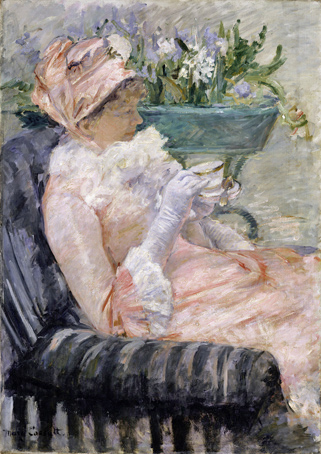
No. 4 - Le Thé. Peinture.
ca. 1880/81 - 92 x 65 cm - Oil on canvas
Metropolitan Museum of Art, New York, USA >
Provenance: Moffett/Berson/Newspaper reports from 1881
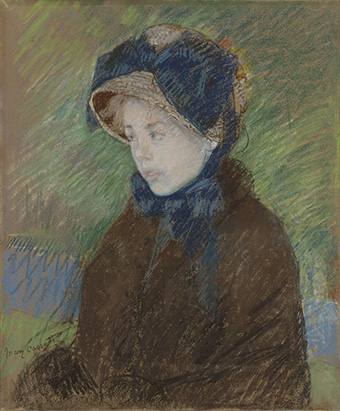
No. 5/6
- Tête de jeune fille. Pastel.
ca. 1881 - 62 x 51 cm - Pastel on paper
Art Institute of Chicago, USA >
Provenance: Moffett/Berson/Newspaper reports from 1881
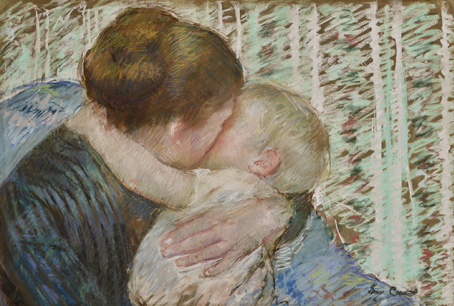
No. 8 - Mère et Enfant. Pastel.
1880 - 42 x 63 cm - Pastel on brown paper
Private collection
Provenance: Moffett/Berson/Sotheby's/Newspaper reports from 1881
Paul Gauguin
One critic, Joris Karl Huysmans, who until the 1881 exhibition had had little to do with the Impressionists, wrote in a newspaper on the occasion of the 6th exhibition: "the new, long-sought formula has been fully realised...". Impressionism had turned away from aphasia and had miraculously become comprehensible. He found Degas' statuette to be "the only truly modern attempt I know of in sculpture..." (J.-R. Huysmans - "L'Exposition des indépendants en 1881" in L'art moderne)
He was also full of praise for Paul Gauguin. He described one act in detail:
10 Works in the catalogue
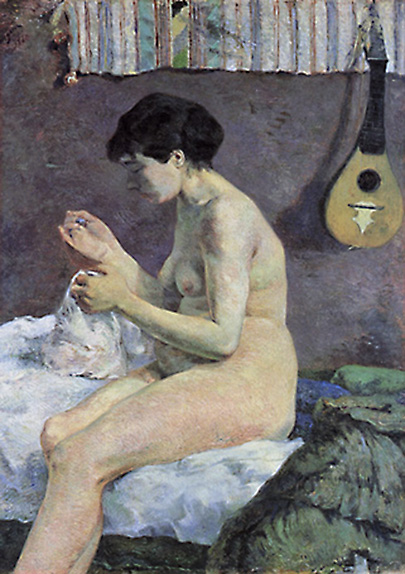
No. 36 - Étude de nu.
1880 - 111 x 79 cm - Oil on canvas
Ny Carslberg Glyptothek, Copenhagen, Denmark
Provenance: Moffett/Berson/Gauguin - Catalogue Raisonné Wildenstein No. 39
"Here is a girl of our day, a girl who does not pose for the public, who, neither lewd nor posed, is simply busy mending her clothes ... The naked woman! Who has painted her as she is, splendid and real, unaffected, without falsifying her features and body?" (J.-K. Huysmans "L'Exposition de indépendants en 1881" in L'Art moderne) Huysmans is probably exaggerating Gauguin's achievement a little when compared with that of Degas or Renoir.
Overall, however, a kind of trend reversal was recognisable in the way Impressionist painting was judged by the press and the public. Manet and Renoir were now recognised in the official Salon and there were already some painters there who were beginning to orientate themselves towards the Impressionist style of painting.
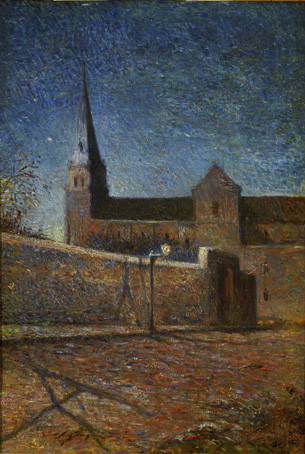
No. 30 - Une nuit à Vaugirard.
1879 - 50 x 34 cm - Oil on canvas
Groninger Museum, on loan from the J.B. Scholten Fund Foundation, Netherlands >
Provenance: Moffett/Berson/Gauguin - Catalogue Raisonné Wildenstein No. 30/Newspaper reports from 1881
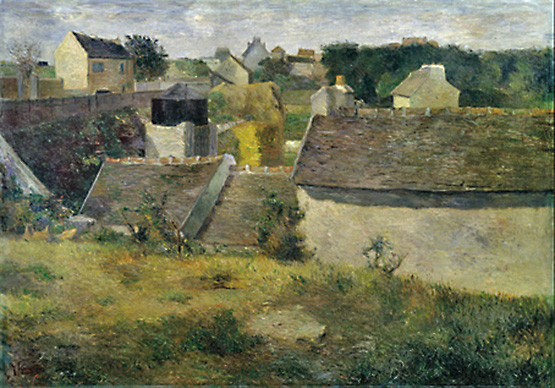
No. 31/32 - Le terrain de ma propriétaire.
1880 - 81 x 116 cm - Oil on canvas
Israel Museum, Jerusalem, Israel >
Provenance: Moffett/Berson/Museum/Gauguin - Catalogue Raisonné Wildenstein No. 44/Newspaper reports from 1881
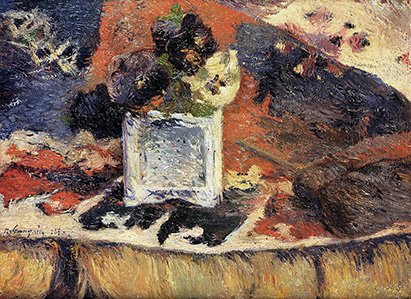
No. 33 - Fleurs et Tapis.
1880/81 - 24 x 32 cm - Oil on wood
Private collection
Provenance: Moffett/Berson/Gauguin - Catalogue Raisonné Wildenstein No. 48/Newspaper reports from 1881
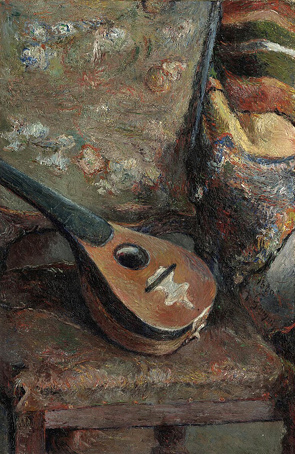
No. 34 - Sur une chaise.
1880 - 47 x 31 cm - Oil on canvas
Menard Art Museum, Komaki, Japan
>
Provenance: Moffett/Berson/Gauguin - Catalogue Raisonné Wildenstein No. 46
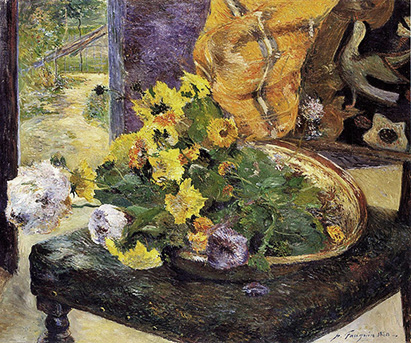
No. 35 - Pour faire un bouquet.
1880 - 55 x 65 cm - Oil on canvas
Private collection
Provenance: Moffett/Berson/Christie's/Gauguin - Catalogue Raisonné Wildenstein No. 49/Newspaper reports from 1881
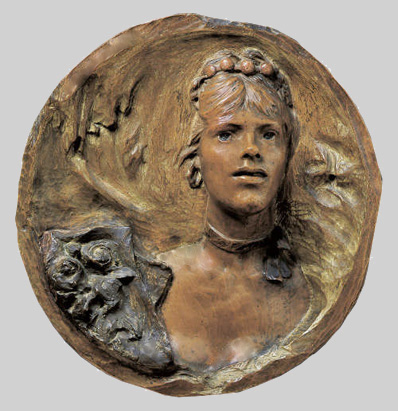
No. 38 - La Chanteuse. Médaillon. (Sculpture).
1880 - 54 x 51 x 13 cm - Mahogany wood and gypsum
Ny Carlsberg Glyptothek, Copenhagen, Denmark
Provenance: Moffett/Berson/Newspaper reports from 1881
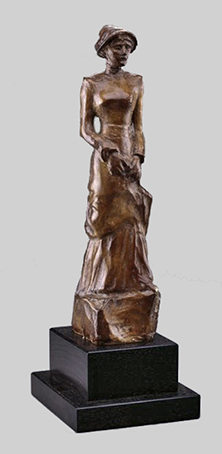
No. 39 - Dame en promenade. (Figurine en bois).
1881 - 25 cm high - Tropical laurel wood stained red and black
Art Institute Chicago, USA >
Provenance: Moffett/Berson/Museum/Newspaper reports from 1881
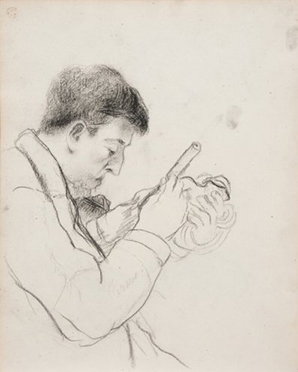
Camille Pissarro: Gauguin Carving the 'Dame en promenade'
23.3 x 29.7 cm – Drawing in black chalk – National Museum, Stockholm
(not in the exhibition)
Armand Guillaumin
Guillaumin had already taken part in previous Impressionist exhibitions. Even though he is not so well known, he can be described as a painter of this art movement. His training was initially self-taught, as he had to earn his living working for the railway company or a road construction office. At the Suisse Academy, he met Cézanne and Pissarro, with whom he remained lifelong friends. Guillaumin mainly painted landscapes.
16 Works in the catalogue
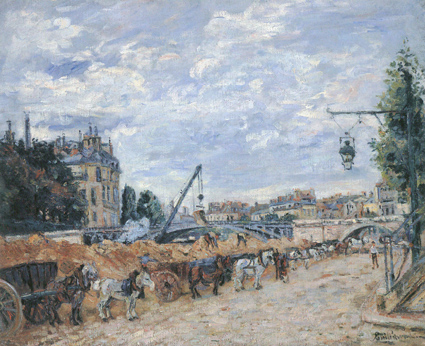
No. 43 - Quai Sully.
ca. 1878 - 59 x 71 cm - Oil on canvas
Petit Palais, Musée d'Art Moderne, Geneva, Suisse
Provenance: Moffett/Berson
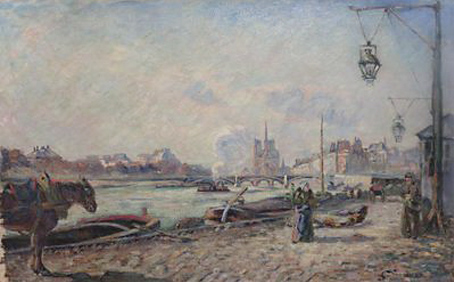
No. 45 - Quai de la Râpée.
ca. 1881 - 50 x 79 cm - Oil on canvas
Private property
Provenance: Moffett/Berson/Newspaper reports from 1881
Berthe Morisot
"Berthe Morisot's speciality lay in the fact that she lived her painting and painted her life, as if the interrelation between observation and action, between creative will and light was a natural and necessary function for her that was closely linked to her life plan. Just as we pick up a thought and drop it again, she picked up a brush and put it down again." (Paul Valery)
She is said to have been strong-willed and self-critical. In order to succeed as an artist, she had to stand up to the prejudices of 19th century bourgeois society. Thanks to her middle-class background, she was materially secure. It was therefore somewhat easier for her to create an extensive body of work.
Her motifs were limited to portraits and landscapes of her surroundings. She captured all the nuances with a delicate colour palette. Following the example of her friends Édouard Manet, Pierre-Auguste Renoir and Claude Monet, her colours and brushstrokes changed over the years, but she always incorporated her very own style into her work.
She only submitted very few works to the 1881 exhibition.
7 Works in the catalogue
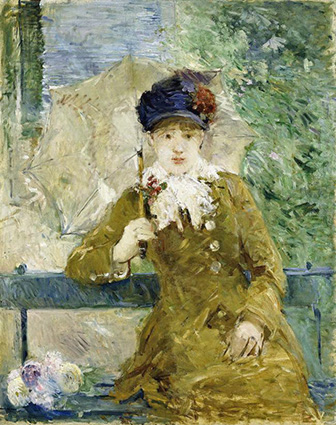
No. 56 - Etude de plein air.
ca. 1880 - 92 x 73 cm - Oil on canvas
Private collection
Provenance: Moffett/Berson/Newspaper reports from 1881
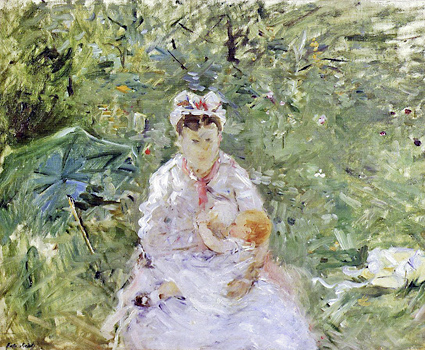
No. 57 - Nourrice et Bébé.
1879/80 - 50 x 61 cm - Oil on canvas
Private collection
Provenance: Moffett/Morisot - Catalogue Raisonné Wildenstein No. 94/Newspaper reports from 1881
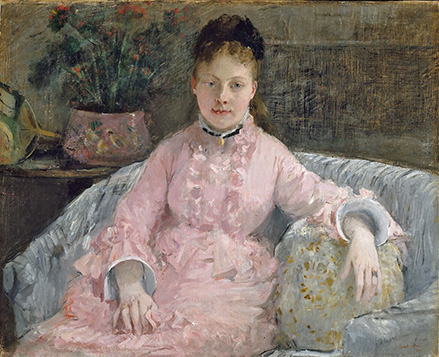
No. 58 - Jeune femme en rose.
ca. 1870 - 55 x 67 cm - Oil on canvas
The Metropolitan Museum of Art, New York, USA >
Provenance: • Moffett/Morisot - Catalogue Raisonné Wildenstein No. 31
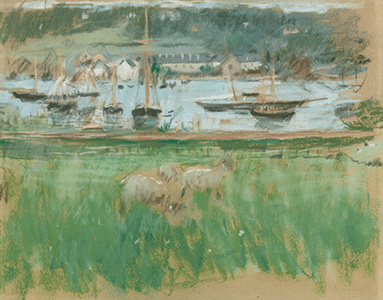
No. 62 - Paysage.
1879/80 - 32,4 x 36,2 cm - Pastel on paper
Private collection
Provenance: • Morisot - Catalogue Raisonné Wildenstein No. 430/Newspaper reports from 1881
Camille Pissarro
Around 1880/1881, Camille Pissarro changed his painting style. He intensively studied the theory of colour again and now worked with pure, unmixed complementary colours. He also used shorter and shorter brushstrokes in order to achieve a blending of the pure colours into an overall harmony for the viewer. In terms of content, he depicts peasant life in a non-pathetic way. The peasant women with their bonnets and long dresses indicate that he never forgot his masters Courbet and Millet in his work.
Théodore Duret wrote that Pissarro's Impressionism was devoid of any transience: "...his descriptions of nature are characterised by their simplification, which nevertheless also expresses the aspect of permanence. (...) Pissarro's paintings convey the impression of vastness and solitude to the highest degree, a certain melancholy emanates from them".
28 Works in the catalogue
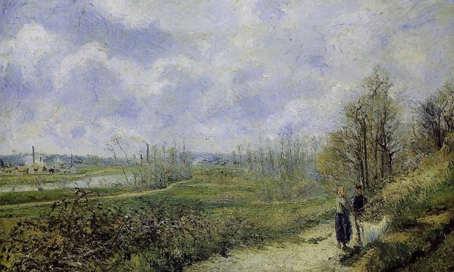
No. 63 - La Sente du choux en mars.
1878 - 57 x 92 cm - Oil on canvas
Musée de la Chartreuse, Douai, France >
Provenance: Moffett/Berson/Wildenstein: Pissarro Vol II Nr 542Newspaper reports from 1881
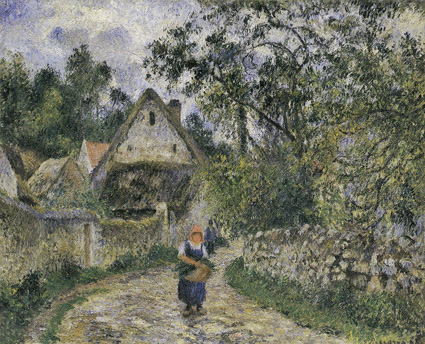
No. 68 - Chaumières au Val Hermé.
1880 - 59 x 72 cm - Oil on canvas
Private collection
Provenance: Moffett/Berson/Wildenstein: Pissarro Vol II Nr 631
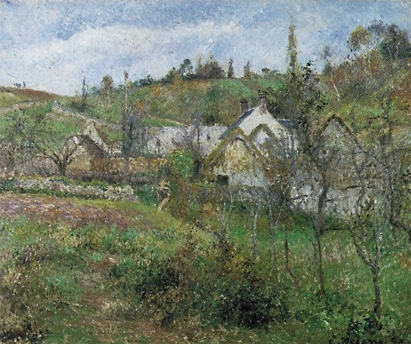
No. 69 - Chaumières au Val Hermé.
1880 - 54 x 65 cm - Oil on canvas
Private collection
Provenance: Moffett/Berson/Wildenstein: Pissarro Vol II Nr 639
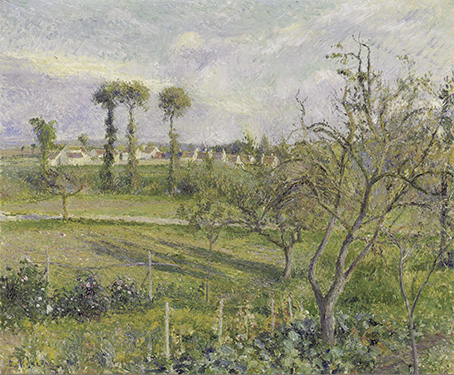
No. 71 - Soleil couchant (La Pleine au choux).
1880 - 54 x 65 cm - Oil on canvas
Private collection
Provenance: Sotheby's/Wildenstein: Pissarro Vol II Nr 621/Newspaper reports from 1881
Gouaches
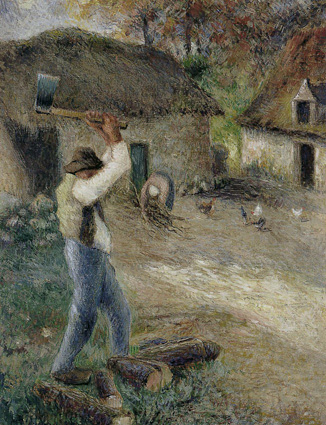
No. 78 - Fendeur du bois.
1880 - 32 x 21 cm - Gouache on paper
Private collection
Provenance: Moffett/Berson/Sothebys/Newspaper reports from 1881
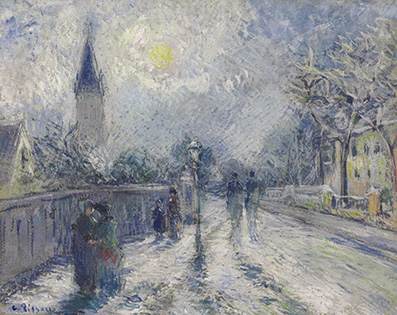
No. 81 - Une Rue à Lower Norwood (environs de Londres).
ca. 1871 - 19 x 24 cm - Gouache on paper
Private collection
Provenance: Berson
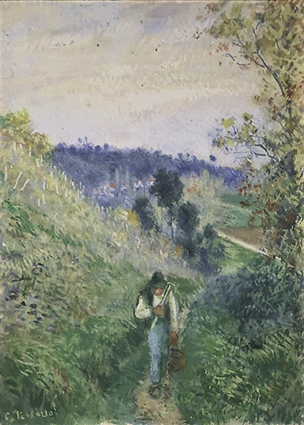
No. 82 - Paysage. Couache
ca. 1871 - 30 x 22 cm - Tempera on canvas
Ny Carlsberg Glyptotek, Kopenhagen, Denmark
Provenance: Moffett/Berson
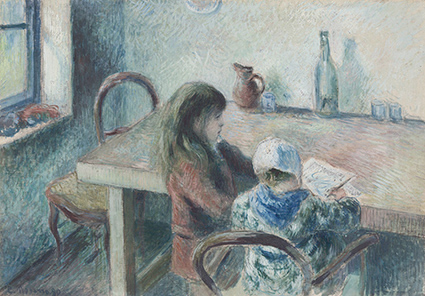
No. 83 - Enfants dessinant.
1880 - 30 x 42 cm - Gouache on paper
National Gallery of Art, Washington, USA >
Provenance: Moffett/Berson/Museum/Newspaper reports from 1881
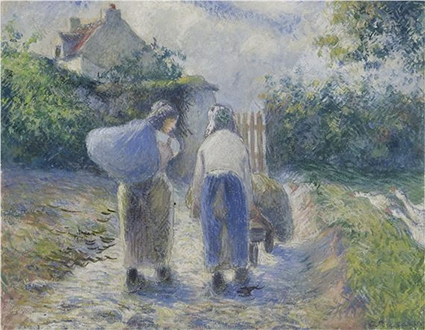
Nr. 85 - Le Retour à la ferme.
1881 - 25,1 x 32,4 cm - Gouache, pastel and watercolour on paper
Private collection
Provenienz: Moffett/Berson/Sotheby's/Newspaper reports from 1881
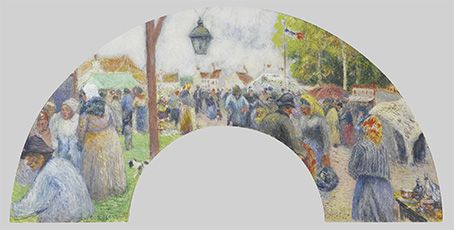
No. 86 - La Foire de la Saint-Martin à Pontoise.
1881 - 27,8 x 55 cm - Gouache on silk
Private collection
Provenance: Moffett/Sotheby's/L. R. Pissarro & L. Venturi, Camille Pissarro, Son art - son oeuvre, vol. I+II/Newspaper reports from 1881
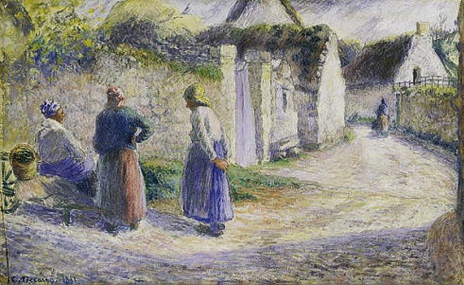
No. 87 - Paysannes du Val Hermé causant dans la rue.
1881 - 28 x 46 cm - Gouache on paper
Private collection
Provenance: Moffett/Berson/Newspaper reports from 1881
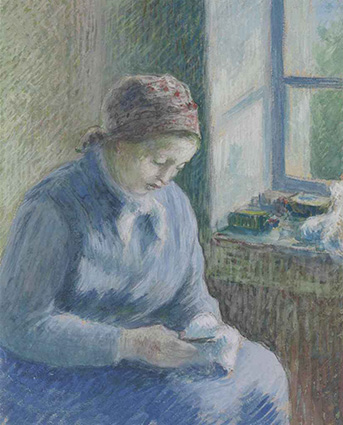
No. 88 - La Ravaudeuse.
1881 - 32 x 25 cm - Gouache on paper
Private collection
Provenance: Moffett/Berson/Newspaper reports from 1881
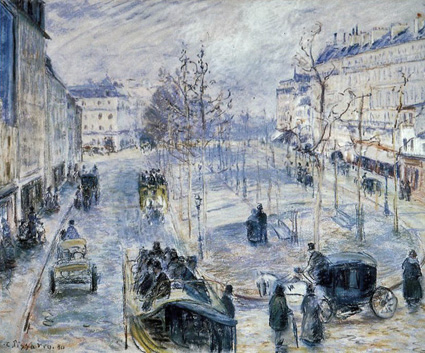
No. 90 - Boulevard Rochechouart. (pastel).
1880 - 60 x 73 cm - Pastel on beige wove paper
The Clark Art Institute, Williamstown, USA >
Provenance: Moffett/Berson/Newspaper reports from 1881
Here are examples by Jean-François Raffaëlli (who contributed the most paintings this time with 34 works) and Frederico Zandomeneghi, whose participation had led to a dispute between the Impressionists and caused Caillebotte, among others, not to take part in this exhibition. There are also paintings by Jean-Louis Forain and Stanislas-Henri Rouart, who also took part in the exhibition.
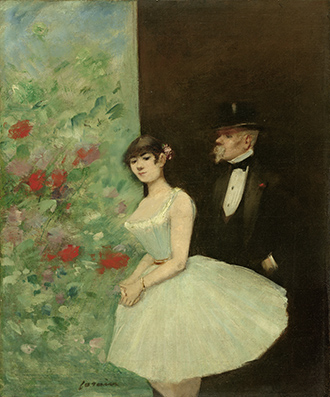
Jean-Louis Forain - No. 20 - Au theatre. Peinture.
1880 - 46 x 38 cm - Oil on canvas
National Gallery of Art, Washington, USA >
Provenance: Moffett/Museum
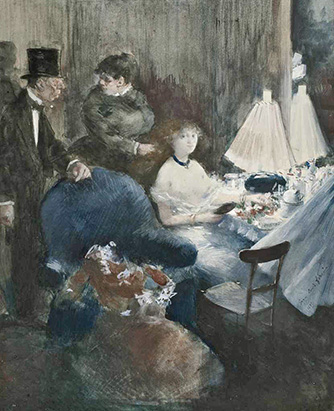
Jean-Louis Forain - No. 22 - Loge d'actrice. Aquarelle.
1880 - 28 x 23 cm - Watercolour, heightened with gouache
Private collection
Provenance: Moffett/Berson/Newspaper reports from 1881
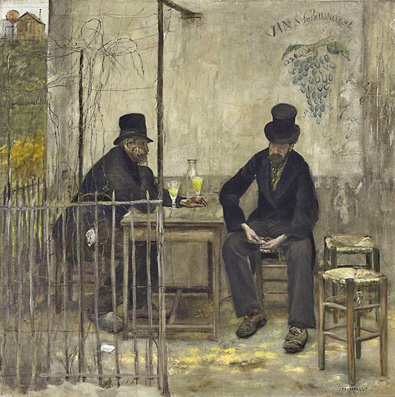
Jean-Francois Raffaëlli - No. 91 - Les Déclassées.
1881 - 108 x 108 cm - Oil on canvas
de Young / Fine Arts Museums of San Francisco, USA >
Provenance: Moffett/Berson/Newspaper reports from 1881
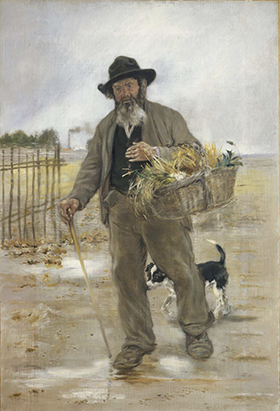
Jean-Francois Raffaëlli - No. 96 - Marchand d'ails et d'échalotes
ca. 1880 - 72 x 49 cm - Oil on paper mounted on canvas
Museum of Fine Arts, Boston, USA >
Provenance: Moffett/Berson/Museum/Newspaper reports from 1881
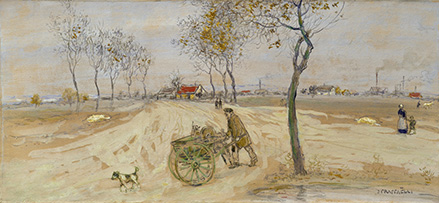
Jean-Francois Raffaëlli - No. 109 - Affûteur de scies.
ca. 1870 - 22 x 47 cm - Oil on paper mounted on canvas
Musée de Grenoble, France >
Provenienz: Berson/Newspaper reports from 1881
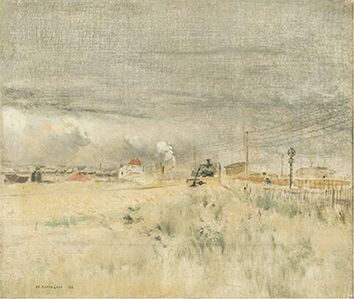
Jean-Francois Raffaëlli - Nr. 115 - Locomotive en manœuvre.
ca. 1880 - 19 x 22,3 cm - Oil on canvas
Private property
Provenienz: Berson/Christie's/Newspaper reports from 1881
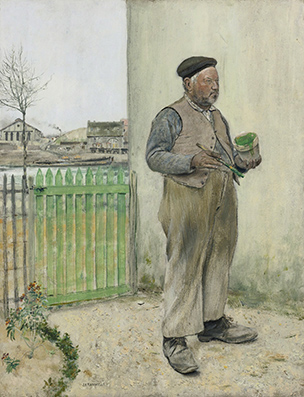
Jean-Francois Raffaëlli - No. 122 - Bonhomme venant de peindre sa barrière.
ca. 1880 - 65 x 50 cm - Oil and charcoal over pencil marks on wooden panel
Private property
Provenance: Moffett/Sotheby's/Newspaper reports from 1881
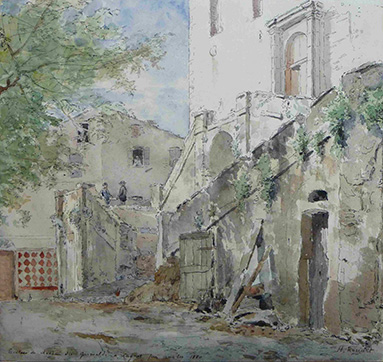
Stanislas-Henri Rouart - No. 132 - Escalier du Château des Grimaldi à Cagues.
1880 - 25 x 27 cm - Watercolour on paper
Musée de Beaux Arts, Orleans, France
Provenance: Moffett/Berson
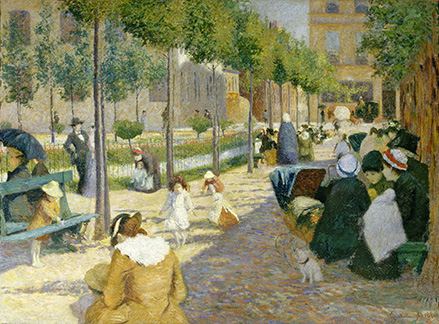
Frederico Zandomeneghi - No. 166 - La Place d'Anvers.
1880 - 100 x 133 cm - Oil on canvas
Galleria d'art moderna Ricci Oddi, Piacenza, Italy
Provenance: Moffett/Berson/Newspaper reports from 1881
![]()